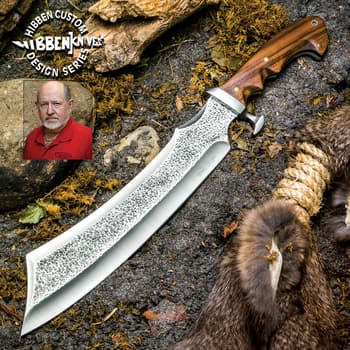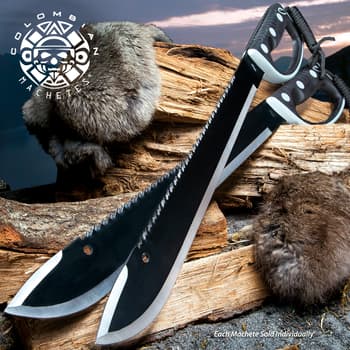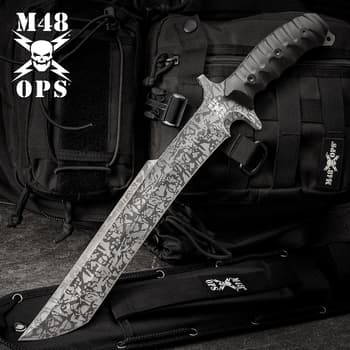What’s A Machete?

By Adelia Ladson
A Brief History Of The Machete
Today’s machetes have their beginnings in ancient Greece’s kopis, the falchion of the Medieval Age, the Germanic seax and the dao of Chinese tradition. The broad-bladed, heavy fixed blade knife found its way into cultures all over the world as a tool, especially, in agriculture. Each culture gave it their own design, but the basic characteristics remained the same. It has a wide, full-tang blade with handle scales attached to the tang and it’s from 12” to 18” in overall length.
What Is A Machete Used For?
Acting as both a knife and an axe, the machete is one of the most versatile fixed blades that you can have in your possession. They come in a variety of styles from survival and self-defense to tactical and utility. They are used for a wide variety of uses like cutting vegetation on an overgrown trail, cutting sugar cane, clearing brush, chopping kindling for fire and even splitting fruit (think coconut). So, when you’re shopping for a machete, the first thing to consider is exactly what you’re going to be using it for the most. Here, I’m focusing on clearing brush and which machete design is the most efficient for that task.
Common Types of Machetes
With its long history of permeating cultures all over the world, machetes come in many styles. Here are the ones that you can find and a brief description of their individual characteristics. You’re guaranteed to find the one that will most meet your needs.
Kukri
The kukri, or Gurkha knife, is a Nepalese machete originally used to clear wooded areas. It was later used as an effective weapon due to its curved design. The shape varies a great deal from being quite straight to highly curved with angled or smooth spines. It can be used to cut, chop, slash or smash just about anything.
Bowie
First popularized by Jim Bowie in the early 19th century because he was "the bearded bloke who took a knife to a gunfight", the Bowie knife is probably one of the best known styles of machete. Decades of hunters and survivalists have found the bowie to be the perfect tool for the wilderness because its basic design has stood the tests of time.
Cane Hook
The cane hook is a wide, straight tipped machete that is traditionally used for hacking corn stalks and sugar cane. It also works great for brush, tall weeds and vines. Typically, the blade has a hook built into the spine to pull the chopped cane or stalks after they’ve been cut.
Bush
Originating in Latin America, a bush machete has a straight-back blade that is hefty and evenly weighted. It’s usually fitted with a sheath and is perfect for cutting vegetation and as just an all-around utility tool.
Parang
Developed originally for clearing paths through the Southeast Asian jungles, the parang has a distinctly curved, front-reinforced “golok” profile with a curved blade kinda like a scimitar. The weight-forward design gives you more swinging momentum, allowing for greater cutting power with less effort.
Hawkbill
The hawkbill machete has the blade profile that resembles a hawk’s beak with a sharp downward curve, thus, the name. The blade can be sharpened on either side, giving you maximum cutting real estate and the penetrating point allows for piercing tasks. The inner curve of the blade makes reaping vegetation a breeze.
Bolo
The bolo machete has its origins in the Philippines and is also primarily used for clearing vegetation for both agricultural tasks and trail blazing. As a side note, it’s also used in Filipino martial arts training. It has a distinctive bulge, adding a heft to the fore-blade that maximizes the chopping power and the handle is usually a native hardwood or animal horn.
Barong
Also, a Filipino machete, the barong has a thick, leaf-shaped blade that is weighty to add to its slicing capability. Used by Muslim tribes in the Philippines, they were primarily a weapon of choice for warfare and hunting. However, the blade profile makes them excellent as an agricultural tool, as well.
My Favorite Machetes
Below are five of the top machetes that I’ve picked from a list of customer favorites. Each has its own merits but any of them would be a great buy.
Ridge Runner Brimstone Canyon Machete
Big, bad and savage! That’s exactly what you’re getting with the Ridge Runner Brimstone Canyon Machete. It has a massive 12” stainless steel blade that’s slightly upswept for added chopping power. It’s perfect for hacking limbs and slashing plant stalks. The sturdy stainless steel guard protects your fingers from the blade and the pakkawood handle gives you a secure grip. The heavy-duty, stainless steel pommel is curved down to keep your hand from sliding off the end of the handle. The machete is an impressive 17” overall but comes with a belt sheath for easy carry.
1918 Combat Kukri Trench Knife
Taking two iconic knife styles and masterfully combined them together, the 1918 Combat Kukri Trench Knife is a machete that’s battle-ready. It has the kukri blade with its effectively curved profile and the trench knife knuckle guard handle. The blade is made of premium carbon steel and the handle is solid brass. You won’t find a tougher machete! It also comes with a sheath for carry.
The Revelator Machete
Despite its overall size, The Revelator Machete is easy to manipulate and blade cut-outs lighten its weight. Whether you’re trekking through vine-choked jungles or snowbound mountain passes, this machete is an outdoorsman’s dream. The full-tang, stainless steel blade is balanced and sharp. The pakkawood handle scales give you a firm grip so that you can tackle brush around the house or a path through the wilderness. The zippered, nylon belt sheath lets you carry it comfortably at your side.
SHTF Jungle Hunter Machete
The SHTF Jungle Hunter Machete is actually my favorite because it’s packed with features, making it capable of literally tackling any chore. What puts it ahead of the other machetes is that the 10” stainless steel blade has a sawtooth spine and a piercing tanto point. It makes quick work of kindling for a campfire or penetrating and slashing canvas. The high-impact, polymer handle has a rubberized grip to give you maximum control even in the soggiest wetlands. This machete is your go-to for any outdoor adventure or mission.
United Cutlery Colombian Rescuer Sawback Machete
At two feet overall, the United Cutlery Colombian Rescuer Sawback Machete is a complete beast of a survival tool. The 18” stainless steel blade has a sawback spine and is non-reflective black. The machete has a saber-style handle that’s injection-molded and rubberized, giving you the ultimate grip. It also features a wrist lanyard to assure that it won’t come out of your hand during hard-use. A nylon belt sheath lets you carry it anywhere.
Related Products
























